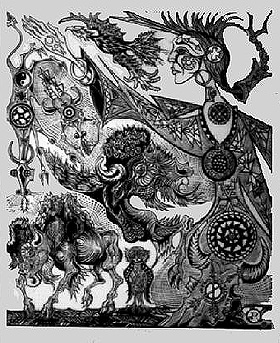| "White
Buffalo Woman" by Jay Rummel
|
Jay Rummel Linocut, 1988 Jay Rummel is a dedicated folklorist, well-known musician and visual artist. His fascination with Western mythology seems to characterize his entire life and is rooted in his formative years growing up on a ranch north of Helena, Montana. The experience there became the beginnings of formal studies pursued years later at the University of Montana and as a potter in Montana and California. He returned to his native state in 1974 to devote himself to his art and music. A published songwriter, he recorded an album in 1979 which is now considered a collector's item. His visual art -shown since the early 60s - is included in collections throughout the West. Appreciative of the production of the Rattlesnake Valley Press Centennial Portfolio, Rummel is "very honored" to be included with other artists who have produced a significant body of work. It is clearly for him a company of colleagues, and he does not hesitate to call himself a regional artist - and one who still loves Western art, "not so much the fact, but the spirit..." Rummel's own work is replete with references to Native American mythology, and he counts those stories that surrounded him as a child as the source of his iconography. Whether working in ceramics, painting or graphics, Rummel fills his spaces with organic, incredibly detailed images that tell the story of the Western land and its people. His piece for the Portfolio, "Interpretation of the Legend of White Buffalo Woman" draws upon Native American myths and symbols, but the story is told in the style of the psychedelic art of the late sixties which continues to influence Rummel's art. The stamp of Charlie Russell is less apparent to the viewer but it is still very real to Rummel whose appreciation of Russell's "unique ability to instill movement even in the stationary figure" is everywhere seen: undulating forms dance across the surface of the print. Rummel's artistry is undivided - music and visual form seem one. --From the Rattlesnake Valley Press Centennial Issue, 1989, Margaret Mudd |

